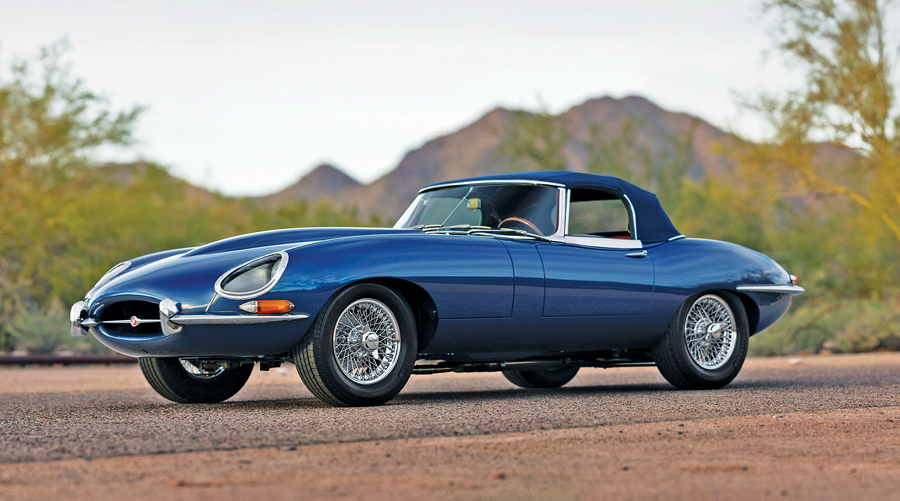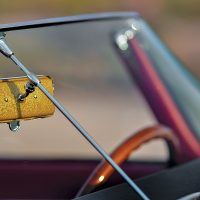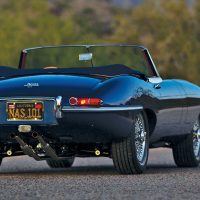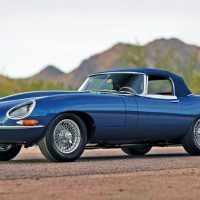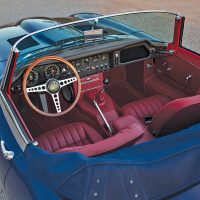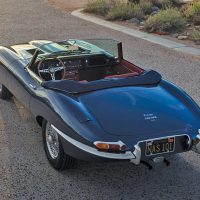SCM Analysis
Detailing
| Vehicle: | 1966 Jaguar E-Type Series 1 4.2-Liter Convertible |
| Years Produced: | 1964–68 |
| Number Produced: | 9,548 |
| Original List Price: | $5,384 |
| SCM Valuation: | $151,500 |
| Chassis Number Location: | Plate on step at front of right sill |
| Engine Number Location: | On rear face at front of cylinder head |
| Club Info: | Jaguar Clubs of North America |
| Website: | http://www.jcna.com |
| Alternatives: | 1958–63 Aston Martin DB4, 1963 Chevrolet Corvette, 1960–67 Austin-Healey 3000 |
| Investment Grade: | B |
This car, Lot 248, sold for $271,600, including buyer’s premium, at RM Sotheby’s Arizona Auction on January 17, 2020.
Who doesn’t recognize a Jaguar E-type when one purrs on by?
Sporting the most iconic and distinctive classic sports-car shape, the E-type was a success from its debut in March 1961. The E-type went through a series of engine upgrades and subtle styling changes until the end of production 15 years later.
Expensive beauty
The ethereal styling depends in part on the fact that the entire front of the car, including bonnet, fenders and faired-in headlamps, tilts forward to expose the engine and front suspension.
This feature makes the E-type incredibly expensive to restore if it’s had any front-end damage at all. And some damage is likely, as the tiny front bumpers are nothing more than extra trim pieces and offer absolutely no protection against damage.
With the bonnet open, the second drop-dead-gorgeous feature of the car is exposed. If Jaguar is recognized for the aerodynamic and eye-pleasing curves of the body lines, the company is equally recognized for the glorious appearance of their dual-overhead-cam, inline-6-cylinder engine.
The suspension parts that are also exposed when the bonnet is tilted forward are equally lovely — when in show condition. While this wide-open front clip is a mechanic’s delight and very useful in endurance racing, it is the bane of concours detailers, as every single small shiny bit is visible.
Fun to drive and collectible
Today, the E-type is perhaps the most desirable collector car of all series-production cars ever manufactured, with prices extending well into the mid-six-digit range. Prices have tailed off a bit from their neck-snapping heights of a few years ago, but E-types still spark collector interest for collectibility and road performance.
Our subject car falls into the middle group of the Series I cars (there are three distinct series that subdivide the 15-year production run). While it does not have the original flat floor and front bonnet clamps that set apart the very first units produced, it does have the powerful — and more practical — 4.2-liter engine and synchronized transmission that replaced the 3.8-liter engine and non-synchro transmission in October 1964.
Color changes
The catalog description does clearly note that the car originally had a different paint color — and a different interior trim color.
Were this, say, a Mercedes-Benz of the same vintage, a collector who wanted a show car might turn and walk away.
Fortunately, since the beginning of the highly competitive and very popular Jaguar Clubs of North America concours d’elegance events, marque elders have decreed that changes to finish and trim colors during restoration are perfectly acceptable without deduction — provided that the new colors were originally available from the factory during the time the particular car was produced.
So no harm, no foul, and the new owner can take delight in the fact that the previous owner paid the big bucks for this cost-no-object restoration. The gorgeous opalescent dark blue paint and red interior replaced the relatively nondescript original silver and blue colors the car wore when it left Coventry in August 1966.
When the car arrived in New York sometime in September of 1966, the dealer registered it as a 1967 car, because that would have been the beginning of the 1967 model year for all the American cars.
A driver — not a shower
This car would never make the field at a big-time concours. Its non-original mechanical upgrades — including the alloy radiator, modern cooling fan and wider tires — are massive concours judging deductions.
Luckily, driving this E-type is more fun than towing it to fancy concours. The new owner is going to want to drive this car and show it off on high-end long-distance tours. Every one of the mechanical changes listed is going to make the car more reliable and roadworthy.
This car’s value lies in its beauty, its performance, its recent restoration — and the sheer fun of lighting it up and driving it on sunny days.
Although the sale price was certainly not inconsequential, the new owner can be pleased that the purchase took place now, rather than at the peak of the market. Even at this level, in its pristine and stunning condition it seems well-bought. ♦
(Introductory description courtesy of RM Sotheby’s.)
